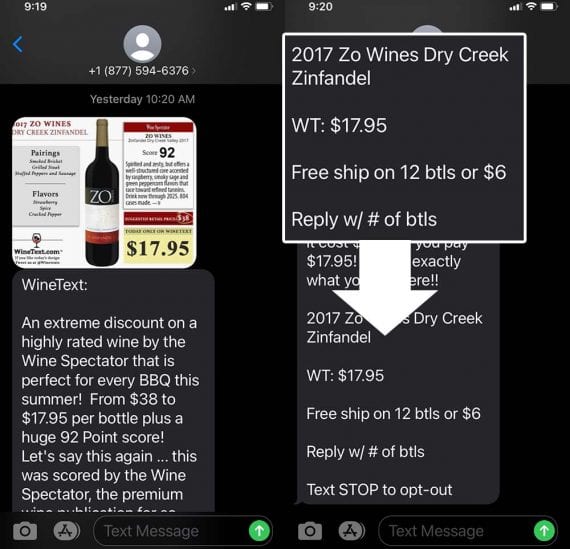Many ecommerce and omnichannel marketers treat text messaging as pared-down email campaigns. But text alone is a powerful way to drive sales. Nearly everyone, after all, grabs their mobile phone the moment a message arrives.
Text Opportunity
“The vision we’ve had is that text messaging could be so much more,” said Blu Atwood, CEO and co-founder of Textual, a shop-by-text platform.
“There is a lot left on the table with the mobile user, meaning if you can make text a more native mobile experience, you have something that makes more sense to the mobile user and more likely to engage them in a transaction,” said Atwood who was speaking during a live interview with the CommerceCo by Practical Ecommerce community on April 29, 2021.
Moreover, text messages may represent a low friction way to sell goods. Atwood pointed to Gary Vaynerchuk’s WineText, a daily text offer for discounted wine.
To start, a consumer signs up on the WineText website, providing payment information and a shipping address. Once registered, the shopper receives a daily wine offer.
On May 26, 2021, for example, the offer was a 2017 Zo Wines Dry Creek Zinfandel. This wine, according to WineText, normally sells for $38 per bottle but was available for one day at $17.95.

WineText asks shoppers to register and provide all of the transactional information needed.
An interested shopper replies to the text message with the number of bottles she would like. That is it. Just reply with a number, and the transaction is complete.

WineText’s daily offer includes a graphic, a relatively long text description, and an easy way to buy: Reply with the number of bottles you want to order.
By almost any definition, this is a low friction transaction.
Atwood noted that “through industry and SMS-commerce colleagues, I have come to find out that [Vaynerchuk] does very well with that, selling out almost all of his offers that he sends.”
Other Use Cases
WineText is a daily discount example of text message commerce, but, according to Atwood, there are other ways that SMS (only text) or MMS (text and other media, such as images) can be used to provide a native mobile, low-friction way to sell products.
Retailers could use text messaging to reduce overstock inventory, such as last season’s fashion or perishable items.
Brands that have traditionally sold wholesale via big-box retailers could use text messaging as a low-cost foray into the direct-to-consumer retail market.
Drop-shippers could sell everything from household goods to fast fashion without having an ecommerce website.
Combined Campaigns
Each of these examples — from WineText’s daily discounts to a retailer selling overstock or a brand going DTC — may be combined with other promotional channels, elevating overall sales.
“We crafted a program with a Fortune 500 company to sell overstock inventory,” said Atwood. “The company places QR codes on packaging and in stores [that] drive consumers to a sign-up page, where they join the exclusive offer club, receive the text-based product offer, and reply ‘yes’ to purchase.”
In this example, packaging and in-store campaigns are combined with low-friction text sales.
Another example might be to combine text shopping with email without duplicating the offer. WineText, for example, sends a secondary (and different) offer via email. This additional option may be related to the text message, such as a different variety from the same winemaker or a similar wine from a different vineyard. In each case, the message complements the text message rather than repeating it.

WineText combines offers: text messages with secondary email.





